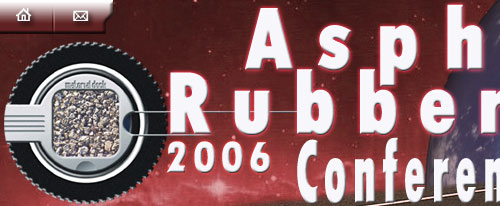


These abstracts has been accepted for the AR2006 Conference. The authors have been invited to submit the full papers to be reviewed for possible acceptance for presentation and/or publication in the AR 2006 Conference and Proceedings.
Download the list of abstracts in PDF (right click, save as)
• |
35 years of use of asphalt-rubber in Arizona. |
• |
A comparison study of rubberized asphalts binders made in the laboratory and filed conditions. |
• |
A laboratory study on the modification of bitumen-rubber with a Fischer-Tropsch process wax. |
• |
A new method to make polymer modified asphalt with crumb rubber and polyphosphoric acid: how to combine recycling and performance. |
• |
A new solution for uncle Sam. |
• |
A study of the use of recycled municipal solid waste (rubber and shredded tyres) in highway construction. |
• |
Aging of rubber modified binders caused by SHRP accelerated aging processes. |
• |
An APT study on the efficiency of asphalt-rubber overlays built in Brazil. |
• |
AR-ACFC overlays as a pavement preservation strategy for PCCP. |
• |
Asphalt rubber chip seal evaluation in California |
• |
Asphalt rubber in Italy highways. |
• |
Asphalt rubber mixtures in Portugal: practical application and performance. |
• |
Asphalt rubber rheology: the zero shear viscosity analysis. |
• |
Asphalt-rubber gap graded mix design concepts. |
• |
Asphalt-rubber open graded friction course reduces tire pavement noise. |
• |
Assessment of the rheological properties of asphalt rubber binder and its residual phases. |
• |
Benchmarking of the performance of wet process method alternatives: terminal or continuous blend. |
• |
Chemical modification of asphalt rubber with polyphosphoric acid. |
• |
Chemically modified crumb rubber asphalt (CMCRA). |
• |
Chemically stabilized rubberbitumens. |
• |
Comparative of asphalts rubber produced in Brazil. |
• |
Construction of the first field section of a flexible pavement using stone matrix asphalt with asphalt-rubber, without fibers, in the state of Bahia. |
• |
Crumb rubber modification of binders: interaction and particle effects. |
• |
Dust mitigation innovations in the city of Phoenix using asphalt-rubber. |
• |
Effect of intensity of grinding on the properties of crumb rubber and its effects on AR binder. |
• |
Effects of compaction temperature on rubberized asphalt mixes. |
• |
Effects of crumb rubber and shale oil on low-temperature properties of binders. |
• |
Effects of crumb rubber on aging of asphalt binders. |
• |
European optimized quiet pavements versus standard U.S. asphalt rubber pavements - the NITE study findings. |
• |
Evaluation of laboratory permeability and correlations to physical mechanical characteristics of asphalt mixes. |
• |
Evaluation of the asphalt rubber regarding elastic recovery and according to south-african tests. |
• |
Evaluation of tire wear emissions, friction and roughness characteristics of asphalt rubber pavements. |
• |
Evaluation of visco-elastic properties in asphalt rubber and conventional mixes. |
• |
Field and laboratory evaluation of asphalt-rubber hot mixtures on a heavy duty road in Brazil. |
• |
Field testing of asphalt rubber/rubber aggregate as a surfacing material for recreational trails. |
• |
Fifteen year performance of asphalt rubber overlay in city of Phoenix. |
• |
Improvement of the functional pavement quality of brazilian pavements through asphalt rubber mixtures. |
• |
In search of the best bitumen rubber asphalt in South Africa. |
• |
Influence of crumb rubber gradation on asphalt rubber properties. |
• |
Laboratory characterization and full-scale accelerated performance testing of Arizona crumb rubber asphalt and other modified asphalt systems |
• |
Laboratory determination of the properties of crumb rubber modified (crabit) asphalt mixtures. |
• |
Laboratory evaluation of Japanese asphalt-rubber mixtures. |
• |
Laboratory investigation of dimensional changes of crumb rubber reacting with the asphalt binder. |
• |
Laboratory studies of ageing in asphalt-rubber binder |
• |
Mechanical evaluation of dense graded mixture prepared with asphalt rubber consider rubber content. |
• |
Mechanical properties of hot mix asphalt s with crumbed rubber and other modifiers. |
• |
Micromechanical crack modeling of viscoelastic asphalt composites with crumb rubber modified matrix. |
• |
Mix design of CRM-HMAC using superpave gyratory compactor and performance testing of CRM-HMAC. |
• |
Mixes for heavy traffic based on crumb rubber modified bitumen |
• |
Multi-layer maintenance and rehabilitation strategies utilizing asphalt rubber binder. |
• |
New testing methods to characterize asphalt binders modified with crumb rubber. |
• |
Optimizing the use of crumb rubber by binary modification. |
• |
Performance of a test track using crumb rubber asphalt and other modifiers. |
• |
Prediction of asphalt pavement temperature using numerical methods. |
• |
Prediction of asphalt rubber properties by using neural artificial networks. |
• |
Recycling products from waste tires and car wrecks for use as binder and asphalt mix modifiers. |
• |
Rehabiltation alternatives using new asphalt rubber mixtures with brazilian materials. |
• |
Rheological behaviour of asphalt with crumbed rubber and other modifiers. |
• |
Rheological properties of binders modified with crumb rubber and shale oil. |
• |
Scrap tire management energy consumption options a cost benefit analysis. |
• |
Sealing the deal. |
• |
Study and application of asphalt rubber and rubberized pavement in China. |
• |
Study of terminal blending asphalt rubber storage and the influence of the test method on high temperatures viscosity determination. |
• |
Taiwan's experience on asphalt rubber pavement. |
• |
Temperature influence in the hot mixes reflective cracking behaviour. |
• |
Temperature influence on fatigue and stiffness properties of asphalt rubber and conventional mixes. |
• |
The effect of crumb rubber modified asphalt mixtures on the structural response of pavements. |
• |
The Influence of the binder type, air voids content, and aging on the performance of the asphalt rubber mixtures. |
• |
The introduction of the South African bitumen-rubber technology to mainland China - a case study. |
• |
The performance of asphalt-rubber and other materials in the Strategic Highway Research Program test sections on interstate 10 near Phoenix, Arizona. |
• |
The rehabilitation of the EN1 major highway In Mozambique using a bitumen-rubber surface treatment. |
• |
The total fracture energy approach to predict the thermal cracking potential of the asphalt rubber mixtures. |
• |
Traffic-induced ground vibrations reduction through an innovative binder course with recycled crumb rubber. |
• |
Use of asphalt rubber for old concrete pavement overlay. |
• |
Use of open-porous friction course with asphalt-rubber for noise reduction in pavements. |

